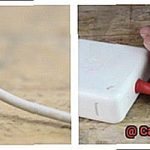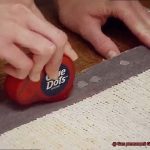Today, we’re diving headfirst into the sticky world of super glue and silicone. Brace yourself for a wild ride as we uncover the truth behind this burning question: can these two formidable materials join forces?
We’ve all encountered silicone in our daily lives, whether it’s those trusty kitchen utensils or even some fancy medical implants. But have you ever stopped to ponder if super glue can conquer this flexible marvel?
So buckle up and get ready to unravel this adhesive enigma – let’s jump right in.
Overview of Super Glue and Silicone
Contents
- 1 Overview of Super Glue and Silicone
- 2 Can Super Glue Stick to Silicone?
- 3 Reasons Why Super Glue May Not Bond with Silicone
- 4 Specialized Super Glues for Bonding Silicone
- 5 Alternatives for Bonding Silicone
- 6 Surface Preparation for Bonding Silicone
- 7 Advantages of Using Specialized Adhesives or Sealants
- 8 Conclusion
When it comes to adhesive materials, two contenders rise above the rest: super glue and silicone. These powerhouses are known for their bonding abilities, but what sets them apart? Join us on a journey into the world of super glue and silicone, where we’ll explore their unique qualities and why they sometimes clash.
Super Glue:
Super glue, also called cyanoacrylate adhesive, is the flash sprinter of adhesives. It forms robust bonds in the blink of an eye, making it a go-to choice for bonding metal, plastic, wood, and glass. The secret behind its speed lies in cyanoacrylate, a compound that reacts swiftly with moisture in the air to create an unbreakable connection.
![]()
Silicone:
Step aside, super glue — silicone is here to steal the show. This flexible and tough polymer finds its calling as a sealant, lubricant, and adhesive extraordinaire. With a resistance to extreme temperatures and an immunity to chemical attacks, silicone stands tall. Its composition of silicon, oxygen, carbon, and hydrogen atoms grants it these exceptional properties.
The Bonding Battle:
In the ring, super glue and silicone face off due to their contrasting compositions and characteristics. Let’s explore why this contest can be so challenging:
- Smooth and non-porous nature: Silicone flaunts a sleek and non-porous surface that poses a formidable challenge for super glue. Without surface irregularities to latch onto, super glue struggles to form a solid grip.
- Low surface energy: Silicone boasts a low surface energy that repels other substances like an elusive temptress. This further hinders super glue’s ability to establish a strong bond.
- Flexibility and heat resistance: Here’s where silicone really flexes its muscles. Its ability to bend with the wind and endure scorching temperatures makes it a tough opponent for super glue. The constant movement of silicone surfaces strains the adhesive bond, leading to potential failures.
Solutions and Alternatives:
While super glue may not have the upper hand when it comes to bonding silicone, fear not. There are alternative options and smart strategies available:
![]()
- Specialized super glue: Some super glue formulations are tailored specifically to enhance bonding with silicone surfaces. These unique variations may contain additives or primers that boost adhesion capabilities.
- Silicone-based adhesives: Enter the heavyweight champion of silicone bonding — silicone-based adhesives and sealants. Crafted with silicone materials in mind, these adhesives offer unrivaled grip, flexibility, and durability.
- Proper surface preparation: Don’t underestimate the power of preparation. By diligently cleaning and degreasing the silicone surface before applying any adhesive, you pave the way for a successful bond. Removing contaminants ensures optimal results.
Can Super Glue Stick to Silicone?
In the vast realm of adhesives, where materials bond and connections are made, there are two formidable contenders: super glue and silicone. Super glue is renowned for its amazing bonding power, while silicone stands out for its flexibility, heat resistance, and water repellency.
But can these two forces unite in a lasting embrace? Let’s embark on a journey to uncover the truth.
Understanding the Chemistry:
Super glue, also known as cyanoacrylate adhesive, boasts the ability to bond with a wide range of materials. However, when it comes to silicone, things get a little complicated. The unique properties of silicone, such as its low surface energy and non-polar nature, pose a challenge for most adhesives trying to form a strong bond.
Slippery When Wet:
Silicone has a smooth and slippery surface, further complicating matters for super glue. The lack of surface roughness reduces the contact area between the adhesive and silicone, thwarting their chances of sticking together like best friends.
Additives: The Barrier Breakers:
To add another layer of complexity, certain additives found in silicone-based products can create a barrier that prevents super glue from properly adhering to the silicone surface. These sneaky gatekeepers, such as plasticizers or release agents, act as formidable obstacles in the bonding process.
A Match Made in Adhesive Heaven:
But fear not. In this tale of adhesive conquest, there are specialized adhesives available that are specifically formulated to bond with silicone materials. These superhero adhesives contain ingredients that enhance adhesion to low-energy surfaces like silicone. With their unique powers, they can conquer even the slipperiest of silicone surfaces.
Preparation is Key:
To ensure a strong bond with silicone, proper surface preparation is crucial. Thoroughly cleaning the surface to remove any contaminants or residues is essential. In some cases, roughening the silicone surface using sandpaper or similar abrasive materials can create more surface area for the adhesive to grip onto.
The Final Verdict:
While super glue may struggle to stick to silicone, there are alternative methods available. Consider using mechanical fasteners or specialized silicone-based adhesives for a reliable bond that won’t let you down.
Reasons Why Super Glue May Not Bond with Silicone
Super glue is renowned for its strength and versatility in adhesive bonding, but there is one material that poses a challenge – silicone. Silicone’s unique properties make it difficult for super glue to adhere to. In this blog post, we will explore the reasons why super glue may not bond with silicone and discover alternative solutions for bonding this tricky material.
The Battle of Chemical Structures:
Super glue and silicone have different chemical structures that hinder their ability to bond together. Super glue reacts with moisture in the air to form a strong adhesive bond. However, silicone lacks reactive sites on its surface, making it resistant to this bonding process.
Contaminants: A Barrier to Bonding:
Silicone surfaces may be contaminated with oils, dust, or release agents during manufacturing or handling. These contaminants act as barriers between the super glue and silicone, preventing them from establishing a strong connection. Thoroughly cleaning the surface before bonding is crucial to ensure successful adhesion.
Low Surface Energy:
Silicone has low surface energy, which means it doesn’t attract or adhere well to other materials. Super glue relies on good surface wetting to create a strong bond. However, silicone’s low surface energy causes the super glue to bead up or form droplets instead of spreading out evenly, reducing its adhesive strength.
Flexibility: A Double-Edged Sword:
Silicone’s exceptional flexibility is an advantage in many applications but can pose challenges for bonding with super glue. As silicone stretches or undergoes deformation, the rigid nature of super glue may not withstand these movements, leading to adhesive failure over time.
Surface Preparation: Key to Success:
Proper surface preparation plays a vital role in achieving a successful bond between super glue and silicone. Roughening the silicone surface using sanding or scoring techniques can increase the effective bonding area. Additionally, using a primer specifically designed for silicone bonding can enhance chemical compatibility and improve adhesion.
Specialized Super Glues for Bonding Silicone
When it comes to bonding silicone materials, ordinary super glue simply won’t do. That’s where specialized super glues come in. These glues have been specifically developed to bond silicone surfaces, offering a range of benefits that ensure a strong and durable connection. In this article, we will explore the importance of using these specialized glues and provide valuable tips for achieving optimal results.
The Magic of Cyanoacrylate Adhesive:
At the forefront of specialized super glues for silicone bonding is the cyanoacrylate adhesive. This glue is known for its quick-drying and robust bonding properties, creating a tight connection between silicone surfaces that guarantees a secure and long-lasting bond. Whether you’re working on a DIY project or an industrial application, choosing cyanoacrylate adhesive can make all the difference.
Preparation is Key:
To achieve the best results with specialized super glues, proper surface preparation is essential. Begin by ensuring that the surfaces are clean and free from any dirt, dust, or oils. Use a mild detergent or alcohol-based cleaner to effectively remove contaminants that could compromise the adhesive’s effectiveness.
Next, roughen the surface of the silicone to create more area for the adhesive to adhere to. Gently sanding the surface with fine-grit sandpaper or using a primer designed specifically for silicone bonding can significantly enhance the strength of the bond.
Follow the Instructions:
Each specialized super glue has specific application guidelines and curing times that must be followed for optimal results. Carefully read and adhere to the manufacturer’s instructions provided with the glue. By doing so, you can ensure that you get the most out of your specialized super glue and achieve a strong bond that will stand the test of time.
Flexibility and Resistance:
In addition to their strong adhesion properties, some specialized super glues for silicone also offer flexibility and resistance to temperature variations. This makes them ideal for applications where the bonded silicone may experience movement or exposure to different temperatures.
Whether it’s sealing joints or bonding silicone components together, these glues provide the versatility you need.
Alternatives for Bonding Silicone
When it comes to bonding silicone, super glue may not always cut it. Fear not. There are alternative methods available that deliver stronger, more durable bonds.
Let’s delve into these alternatives and weigh their pros and cons, empowering you to make an informed decision on the best method for your needs.
Silicone Adhesives:
Designed specifically for bonding silicone materials, silicone adhesives offer a flexible, moisture-resistant bond. Available in liquid, paste, or gel forms, they can be applied using brushes or syringes. These adhesives excel in heat and chemical resistance, making them ideal for harsh environments.
Silicone-Based Sealants or Caulks:
While primarily used for sealing gaps and cracks, silicone sealants and caulks can also effectively bond silicone surfaces. With impressive adhesive properties, they create a robust bond between silicone materials. Choose from an array of colors and effortlessly apply them with a trusty caulking gun.
Epoxy Adhesives:
Certain epoxy adhesives are suitable for bonding silicone materials. Epoxy is a two-part adhesive that requires meticulous mixing before application. The result? A resilient bond that withstands temperature fluctuations and chemical exposure. Ensure compatibility with silicone materials and follow the manufacturer’s instructions to achieve optimal results.
Mechanical Fastening Methods:
For some applications, mechanical fastening methods shine as alternatives or companions to adhesives. Secure silicone components with screws, bolts, or other fasteners for a reliable and reversible bond. Keep in mind that this method may necessitate drilling or creating holes in the material.
Considerations:
- Surface energy and anti-adhesive coatings of silicone materials impact bonding effectiveness.
- Always adhere to manufacturer’s instructions for your chosen adhesive or bonding method.
- Seek professional advice or consult the manufacturer when unsure about the best bonding approach for specific silicone products.
Surface Preparation for Bonding Silicone
Surface preparation is a critical step in achieving a strong and durable bond between silicone and super glue. The success of the bond largely depends on how well the surface is prepared before applying the adhesive. Silicone, with its low surface energy, can be a bit challenging to bond, but with proper preparation, you can ensure adhesive success.
Here are the steps to follow for effective surface preparation:
- Thoroughly clean the silicone surface: Before starting, make sure the surface is free from dirt, dust, oils, and contaminants. Use a mild detergent or solvent to clean the surface, rinse it thoroughly, and allow it to dry completely before proceeding.
- Roughen the surface: Silicone needs some help in the roughness department. Gently sand the surface using sandpaper or a fine-grit abrasive pad in a circular motion. The goal is to create micro abrasions that increase the surface area for better adhesion. Be cautious not to remove chunks of material while sanding.
- Remove loose particles: After sanding, it is essential to remove any loose particles or debris left on the surface. Use compressed air or a soft brush to carefully clean the surface and ensure it is particle-free.
- Consider using a primer or adhesion promoter (optional): To enhance bond strength, you may choose to apply a primer or adhesion promoter specifically designed for silicone bonding. These products create a chemical coupling between the silicone and the adhesive. Follow the manufacturer’s instructions when applying the primer.
- Apply a thin layer of adhesive: Remember that less is more when it comes to super glue and silicone bonding. Apply a thin layer of adhesive evenly on one of the surfaces you want to bond. Applying too much glue can lead to poor bonding and messy results.
- Press and hold: Carefully align the two surfaces after applying the adhesive and press them together firmly. Apply even pressure for the recommended curing time provided by the adhesive manufacturer. Take your time and allow the bond to cure properly.
Advantages of Using Specialized Adhesives or Sealants
Specialized adhesives or sealants have a range of advantages over regular super glue when it comes to bonding silicone materials. These products are specifically formulated to adhere to silicone surfaces, providing enhanced bonding strength that regular super glue just can’t match. With their perfect recipe, specialized adhesives or sealants create a strong and durable bond that lasts.
In addition to enhanced bonding strength, specialized adhesives or sealants offer flexibility. Silicone materials are known for their elasticity and flexibility, which means they experience movements and stresses. Ordinary super glue may not be able to withstand these movements, resulting in a weakened bond or even complete failure. However, specialized adhesives or sealants are designed to be flexible, allowing them to accommodate the natural movements of silicone without compromising the bond.
Specialized adhesives or sealants also provide resistance to extreme temperatures. Silicone materials are often exposed to high and low temperatures, which can cause regular super glue to lose its adhesive properties. This can lead to a weakened bond or even complete failure. However, specialized products are designed to maintain their adhesive capabilities even in extreme temperature environments, ensuring a reliable bond between silicone surfaces.
Chemical resistance is another advantage of using specialized adhesives or sealants. Silicone materials are known for their resistance to chemicals, making them suitable for various industries. Regular super glue may deteriorate when exposed to different chemicals, compromising the bond between silicone surfaces. Specialized adhesives or sealants, however, are formulated to be chemically resistant, ensuring that the bond remains intact even in harsh chemical environments.
Lastly, specialized adhesives or sealants provide waterproof and moisture resistance. Silicone materials are commonly used in applications where waterproof or moisture-resistant properties are required. Regular super glue may not be able to provide an effective barrier against water and moisture penetration, leading to a weakened bond over time. Specialized adhesives or sealants, on the other hand, can create a strong and durable bond that is resistant to water and moisture, ensuring the longevity of the bond between silicone surfaces.
cQGZSkSoxJI” >
Also Read: How To Glue Silicone To Silicone?
Conclusion
In conclusion, the quest to determine if super glue can stick to silicone has been exhaustively explored. These two substances, with their contrasting chemical structures and surface properties, present a formidable challenge when it comes to bonding. However, fear not, for there are alternative options and clever strategies at our disposal.
The smooth and non-porous nature of silicone, coupled with its low surface energy and flexibility, makes it an elusive target for super glue. Yet, through the marvels of modern chemistry, specialized super glues have been concocted specifically for this purpose. These unique variations boast additives and primers that enhance their adhesion capabilities, allowing them to conquer the seemingly insurmountable obstacles posed by silicone.
But let us not forget the power of silicone itself. Silicone-based adhesives and sealants emerge as worthy contenders in this sticky battle. Crafted with silicone materials in mind, these adhesives offer an unparalleled grip that bends and flexes with ease. They possess a durability that withstands the harshest temperatures and chemicals known to man.
To achieve triumph in the realm of super glue-silicone bonding, proper surface preparation is paramount. The diligent cleansing of contaminants and the roughening of surfaces using sandpaper or a primer lay the foundation for successful adhesion.
Though super glue may not be crowned as the ultimate champion in this arena, fret not. Specialized alternatives exist; they hold within them the power to forge unbreakable bonds with silicone materials. By embracing these alternatives and adhering (pun intended) to proper preparation techniques, one can attain reliable adhesive connections with confidence.
So take heart. The question “Can super glue stick to silicone?”





